Click on images to enlarge
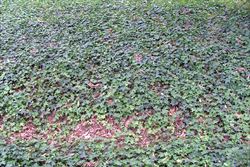
infestation (Photo: Sheldon Navie)
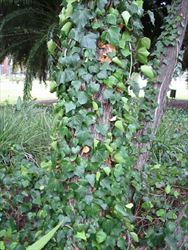
climbing habit (Photo: Sheldon Navie)
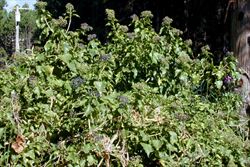
shrubby habit (Photo: Forest and Kim Starr, USGS)
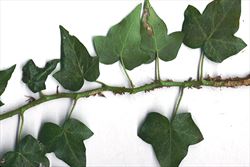
older climbing stem with short aerial roots (Photo: Forest and Kim Starr, USGS)

minutely hairy younger stem (Photo: Sheldon Navie)
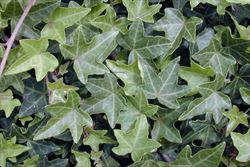
five-lobed lower leaves (Photo: Forest and Kim Starr, USGS)
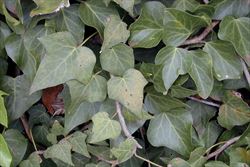
three-lobed lower leaves (Photo: Forest and Kim Starr, USGS)
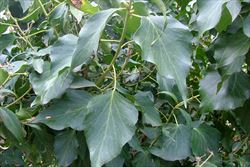
entire upper leaves with wavy margins (Photo: Sheldon Navie)
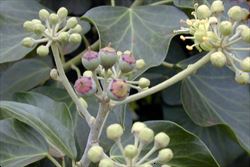
flower buds and immature fruit (Photo: Forest and Kim Starr, USGS)
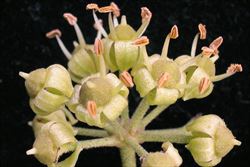
close-up of flowers (Photo: Greg Jordan)

close-up of mature fruit (Photo: Forest and Kim Starr, USGS)
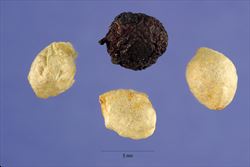
close-up of seeds (Photo: Steve Hurst at USDA PLANTS Database)
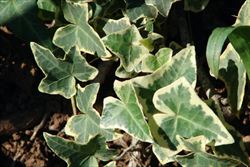
cultivar with variegated leaves (Photo: Forest and Kim Starr, USGS)
Scientific Name
Hedera helix L.
Family
Araliaceae
Common Names
common ivy, English ivy, ivy, needlepoint ivy, ripple ivy
Origin
Native to northern Africa (i.e. Algeria, Libya, Morocco and Tunisia), the Azores, the Madeira Islands, the Canary Islands, all of Europe and western Asia (i.e. Cyprus, Israel, Lebanon, Syria, Turkey, Armenia, Georgia and southern Russia).
Cultivation
A widely cultivated garden plant (i.e. ornamental) that is grown for its attractive variegated foliage. Numerous cultivars are available which vary greatly in leaf shape and colour.
Naturalised Distribution
Widely naturalised in Australia, but primarily found in the southern parts of the country. It is common in eastern New South Wales, Victoria, Tasmania, south-eastern South Australia and south-western Western Australia. Also sparingly naturalised in south-eastern Queensland.
Naturalised overseas in New Zealand, Hawaii, the USA and Canada.
Habitat
A weed of watercourses and riparian areas, wetlands, open woodlands, closed forests, forest margins, roadsides, gardens and pine plantations in temperate regions.
Habit
A climber or creeper that may occasionally become somewhat shrubby with age. When climbing up tall vegetation in can reach up to 20 m or more in height.
Distinguishing Features
- a climber or creeper that may occasionally become somewhat shrubby with age.
- its stems are somewhat woody and produce short aerial roots that attach to supporting structures.
- its leaves (3-15 cm long and 3-10 cm wide) are either shallowly 3-5 lobed or entire.
- these leaves dark green and glossy upper surfaces that are sometimes variegated with white or cream.
- its tiny five yellowish-green flowers are arranged in clusters, with all of the flower stalks emanating from the same point.
- its rounded fruit (5-10 mm across) resembles a berry and turns from green to dull bluish-purple or black as it matures.
Stems and Leaves
Its stems are somewhat woody and produce short aerial roots (i.e. rootlets) that attach to supporting structures. Younger stems are green to purplish or burgundy red in colour and hairless (i.e. glabrous) or minutely hairy (i.e. sparsely pubescent).
The leaves are alternately arranged along the stems and borne on stalks (i.e. petioles) 2.5-11 cm long. They vary from egg-shaped in outline (i.e. ovate) with entire or wavy margins to heart-shaped (i.e. cordate) or shallowly 3-5 lobed (i.e. palmately lobed). In general, the lower leaves tend to be lobed and the upper leaves tend to be entire. These leaves (3-15 cm long and 3-10 cm wide) are hairless or nearly so (i.e. glabrous or glabrescent) with rounded to pointed tips (i.e. obtuse to acuminate apices). Their upper surfaces are slightly darker green and glossier than their undersides, and they are sometimes variegated with white or cream.
Flowers and Fruit
The small flowers are arranged in clusters, with all of the flower stalks (i.e. pedicels) emanating from the same point (i.e. in umbels). One or more of these clusters may be arranged into larger branched clusters (i.e. into a raceme or panicle of umbels). Each flower has five yellowish-green petals (3-5 mm long), but no obvious sepals. They also have five stamens and five partially fused styles (about 1.5 mm long). Flowering occurs mainly during summer.
The fruit resembles a berry (it is actually a drupe) and turns from green to dull bluish-purple or black as it matures. These rounded fruit (5-10 mm across) contain 2-3 whitish seeds. They are normally present during winter and early spring (i.e. from June to September).
Reproduction and Dispersal
This species reproduces by seed and also vegetatively by a variety of methods. Stems that come into contact with the soil develop roots and can form into new plants (a process called layering). Stem segments that have been separated from the rest of the plant can also take root. Creeping underground stems (i.e. rhizomes) may also be produced.
The seeds are dispersed by birds and other animals that eat the fruit. Seeds and pieces of stem can also be spread in dumped garden waste.
Environmental Impact
Ivy (Hedera helix) is regarded as a significant environmental weed in Victoria, the ACT, South Australia, New South Wales and Tasmania. It is listed as a priority environmental weed in five Natural Resource Management regions and is actively managed by community groups in Victoria and Tasmania. This species prefers moist sheltered areas and is extremely tolerant of deep shade. It spreads rapidly, blanketing the ground in a thick mat of vegetation. This excludes light, eventually choking out other species and preventing their germination. Ivy (Hedera helix) also grows thickly up over tall tress and shrubs, smothering them and even causing them to fall over under its weight.
In Victoria, ivy (Hedera helix) has invaded dry and wet sclerophyll forests, woodlands, riparian vegetation, rocky outcrops and warm temperate rainforest. It competes vigorously with native plant species and can dominate understorey vegetation, eventually modifying the whole ecosystem. This widespread invader is listed as a problem species in numerous regions in this state (e.g. in Monash City, Banyule City, Knox City, Sherbrooke Forest and in the Kananook Creek area). It is also threatening the survival of the superb lyrebird (Menura novaehollandiae) in the Dandenong Ranges National Park, by preventing this rare bird species from scratching into the forest litter for food. Ivy (Hedera helix) also poses a serious threat to the survival of the only known population of dainty maidenhair (Adiantum capillus-veneris) in Victoria. This population, located on the edge of Point Nepean National Park, is probably being impacted by the vigorous creeping habit of ivy (Hedera helix).
In New South Wales, ivy (Hedera helix) mainly grows in wet sclerophyll forest and disturbed rainforest south from the Glen Innes district. It appears on numerous local and regional environmental weed lists in this state (e.g. the Warringah Council environmental weeds register, the NSW North Coast environmental weed survey list, and environmental weed lists for the wider Sydney and Blue Mountains region, the Southern Highlands and the South Coast region). This species is also as one of the "exotic vines and scramblers" that are listed together as a "key threatening process" in New South Wales.
In South Australia, ivy (Hedera helix) is a common invasive weed in the Greater Adelaide Region, in Western Australia it is an occasional garden escape in creeklines in the Perth area, and in Tasmania it is reported to invade swamp paperbark forests. Ivy (Hedera helix) is also naturalised in the understorey of forests in Hawaii, infests woodlands, forest edges, coastal areas and salt marsh edges in the USA, forms monocultures in forests in Canada, and grows along riverbeds and stream banks in New Zealand. Because of these widespread and significant impacts, it is listed in the Global Invasive Species Database.
Legislation
Not declared or considered noxious by any state government authorities.
Management
For information on the management of this species see the following resources:
- the Weeds in your Bush section of the Tasmanian Bushcare Toolkit which is available online at http://www.dpiw.tas.gov.au.
- Muyt, A. (2001). Bush Invaders of South-East Australia, pp. 138-140.
Similar Species
Ivy (Hedera helix) can be confused with some other weedy vines when not in flower, including ivy groundsel (Delairea odorata), climbing groundsel (Senecio angulatus), canary creeper (Senecio tamoides) and Natal ivy (Senecio macroglossus). However, none of these species produce short aerial roots (i.e. rootlets) from their stems. When in flower they can all be easily distinguished from ivy (Hedera helix) by their clusters of bright yellow flowers and small wind-blown seeds topped with hairs.

